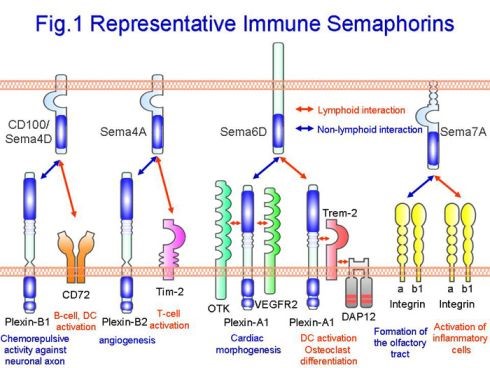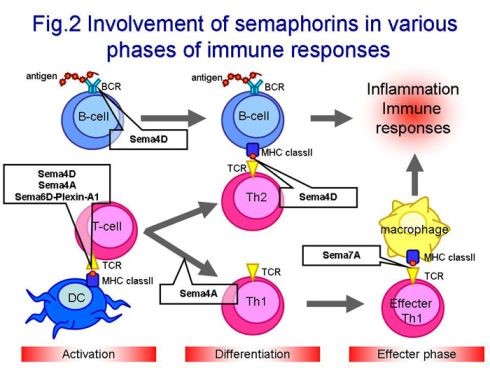Immunopathology
TEL +81-6-6879-3831
FAX +81-6-6879-3839
Overview
Semaphorins are originally identified as axonal guidance factors in the developing nervous system in 1990s. Cumulative evidence suggests that semaphorins also play important roles in the other systems, including organogenesis, vascularization, angiogenesis and the progression of cancers. In 2000, our research groups have identified a class IV semaphorin, CD100/Sema4D, as an immune-regulatory molecule expressed on immune cells. To date, it becomes clear that some other semaphorins (Sema3A, Sema4A, Sema4B, Sema4G, Sema4F, Sema6A, Sema6B, Sema6D, Sema7A) are also expressed in the immune system and play non-redundant roles in immune responses. These semaphorins are now called as ‘immune semaphorins’ (Fig.1). Immune semaphorins are involved in various phases of immune responses including activation phase, differentiation phase and effecter phase (Fig.2). We work on the molecular mechanisms underlying regulation of immune responses by immune semaphorins.


Principal Investigator
Atsushi Kumanogoh Professor

Research field
Immunology
Education history
| 1991 | Graduate from Medical School of Osaka University |
|---|
Research and career history
Prize
| 1991 | Kusumoto Prize, Osaka University |
|---|---|
| 2005 | The 1st JSPS Prize |
| 2005 | The 8th JSI Award |
| 2010 | The 28th Osaka Science Prize |
| 2011 | Prize for Science and Technology by MEXT |
| 2012 | The 1st Osaka University Presidential Awards for Achievement and Presidential Awards for Encouragement |
| 2012 | Mochida Memorial Academic Award |
| 2015 | Elected Membership, American Society for Clinical Investigation (ASCI) |
Members
- Atsushi Kumanogoh Professor
kumanogoimed3.med.osaka-u.ac.jp - Masashi Narazaki Professor
mnarazakiimed3.med.osaka-u.ac.jp - Satoshi Nojima Associate Professor
s_nojimaimed3.med.osaka-u.ac.jp - Yoshito Takeda Associate Professor
yoshitoimed3.med.osaka-u.ac.jp - Tatsusada Okuno Associate Professor
thyotaimed3.med.osaka-u.ac.jp
Achievements
Publications
- Schulz E et al. Nature Commun. 5:5191. 2014.
- Kumanogoh A and Kikutani H. Nature Rev Immunol. 13:802-14. 2013.
- Nojima S et al. Nature Commun. 4:1406. 2013.
- Hayashi T et al. Nature 485:69-74, 2012.
- Nogi T et al. Nature 467:1123-7, 2010.
- Takamatsu et al. Nature Immunology 11, 594-600, 2010.
- Suzuki et al. Nature Immunology 9, 17-23, 2008.
- Suzuki K, Kumanogoh A (*corresponding author) et al. Nature 446, 680-684, 2007.
- Takegahara, N, Kumanogoh A (*corresponding author) et al. Nat Cell Biol. 8, 615-622, 2006.
- Kumanogoh A. et al. Immunity 22, 305-16, 2005.
- Kikutani H. and Kumanogoh A. Nat. Rev. Immunol. 3, 159-167, 2003.
- Kumanogoh A. et al. Nature 419, 629-633, 2002.
